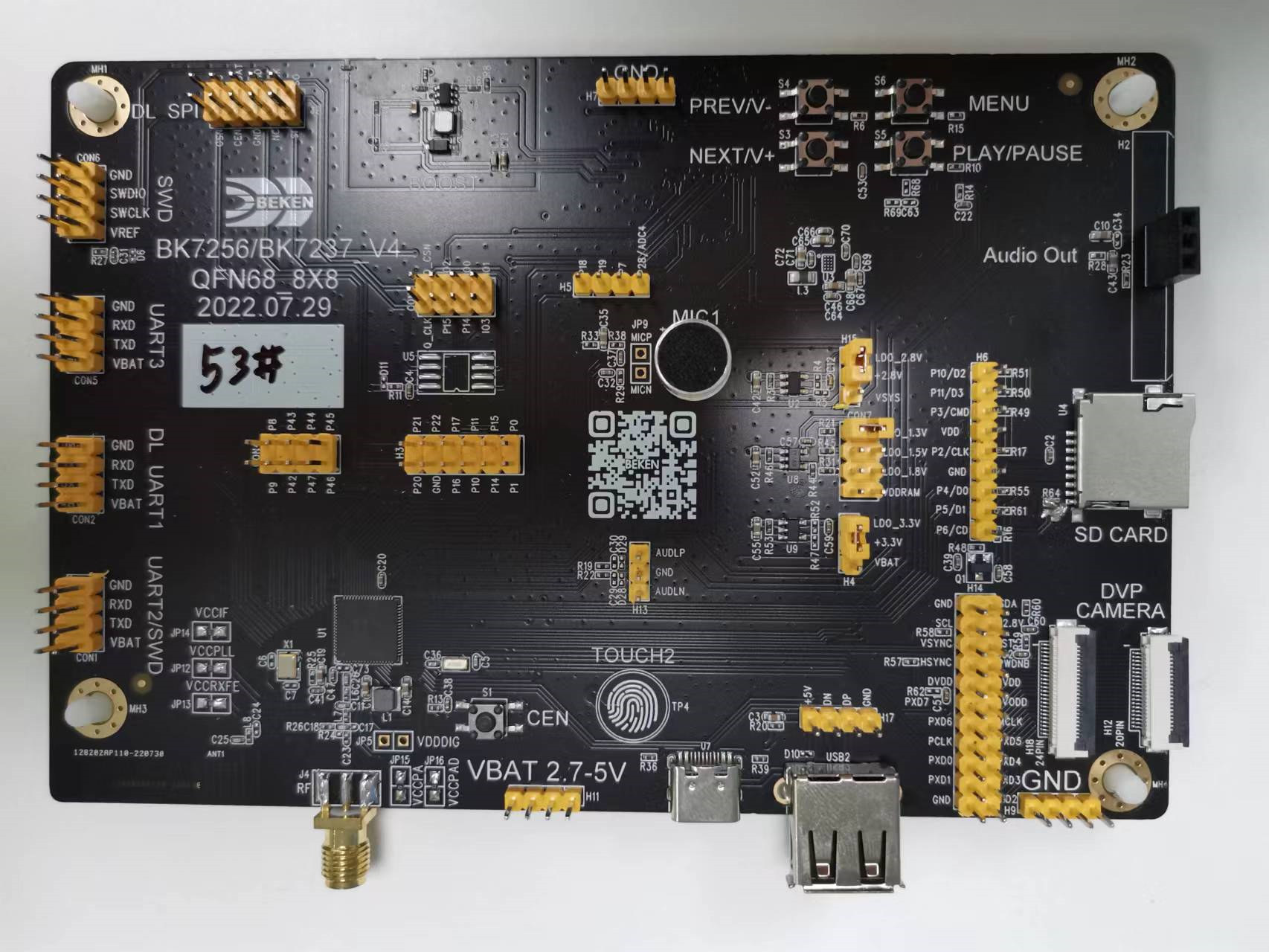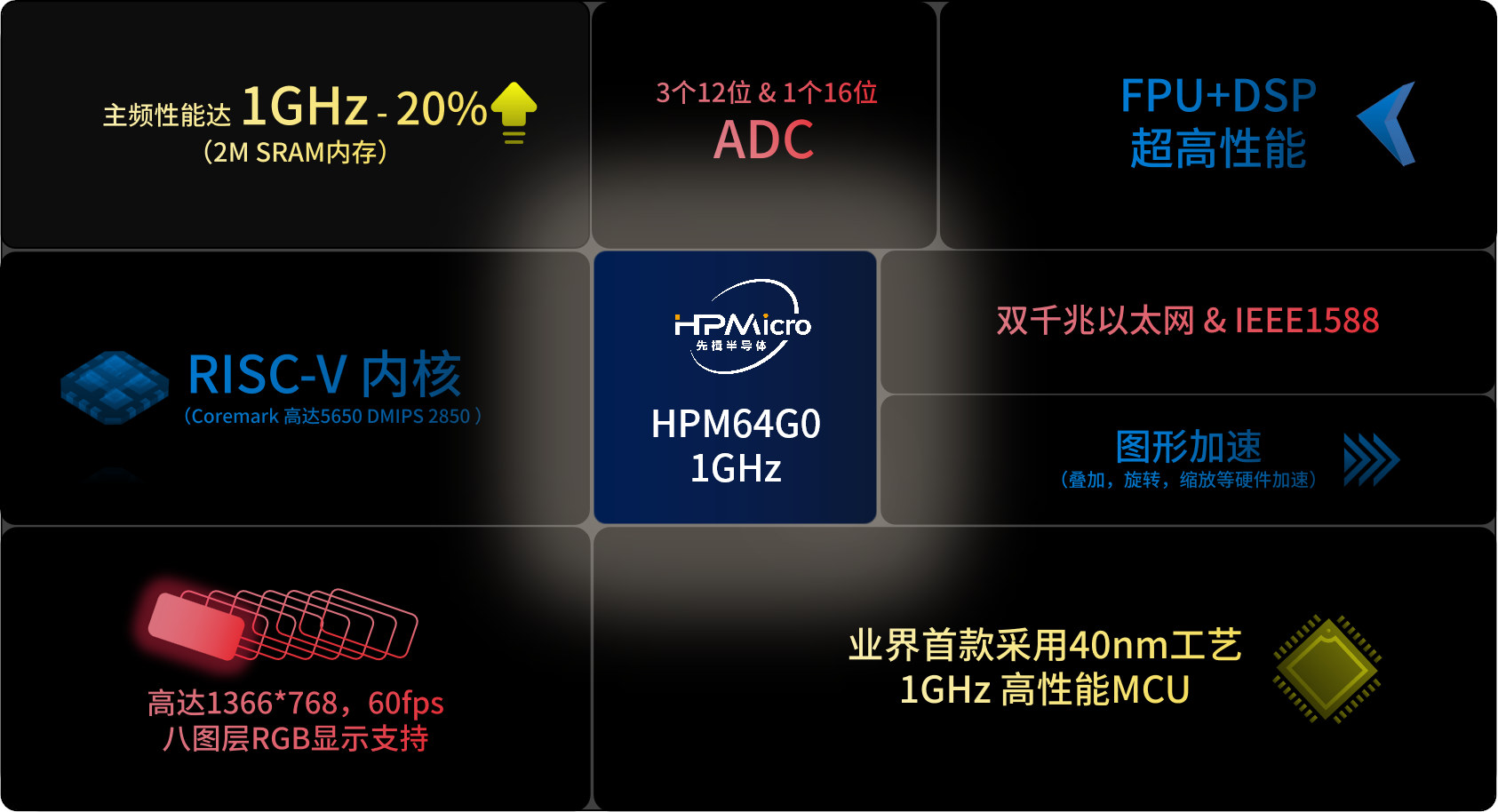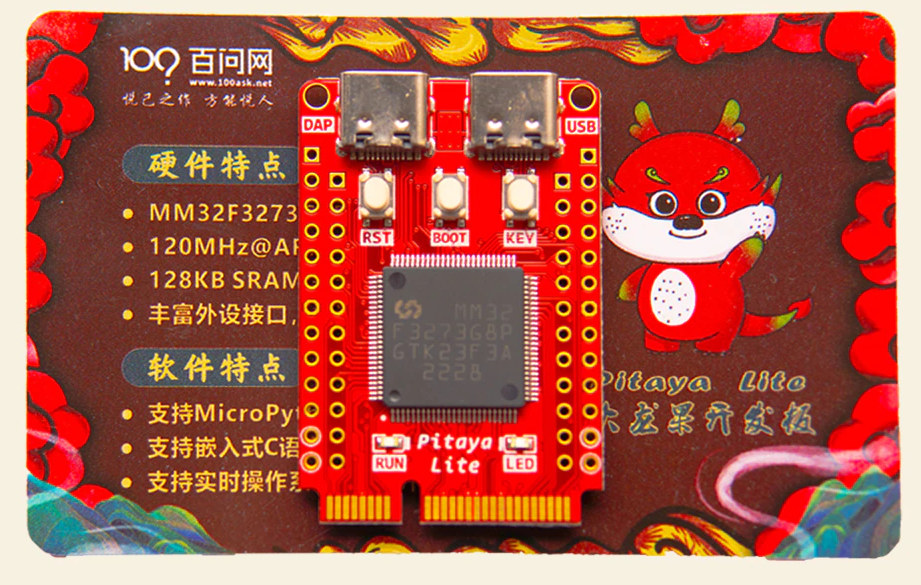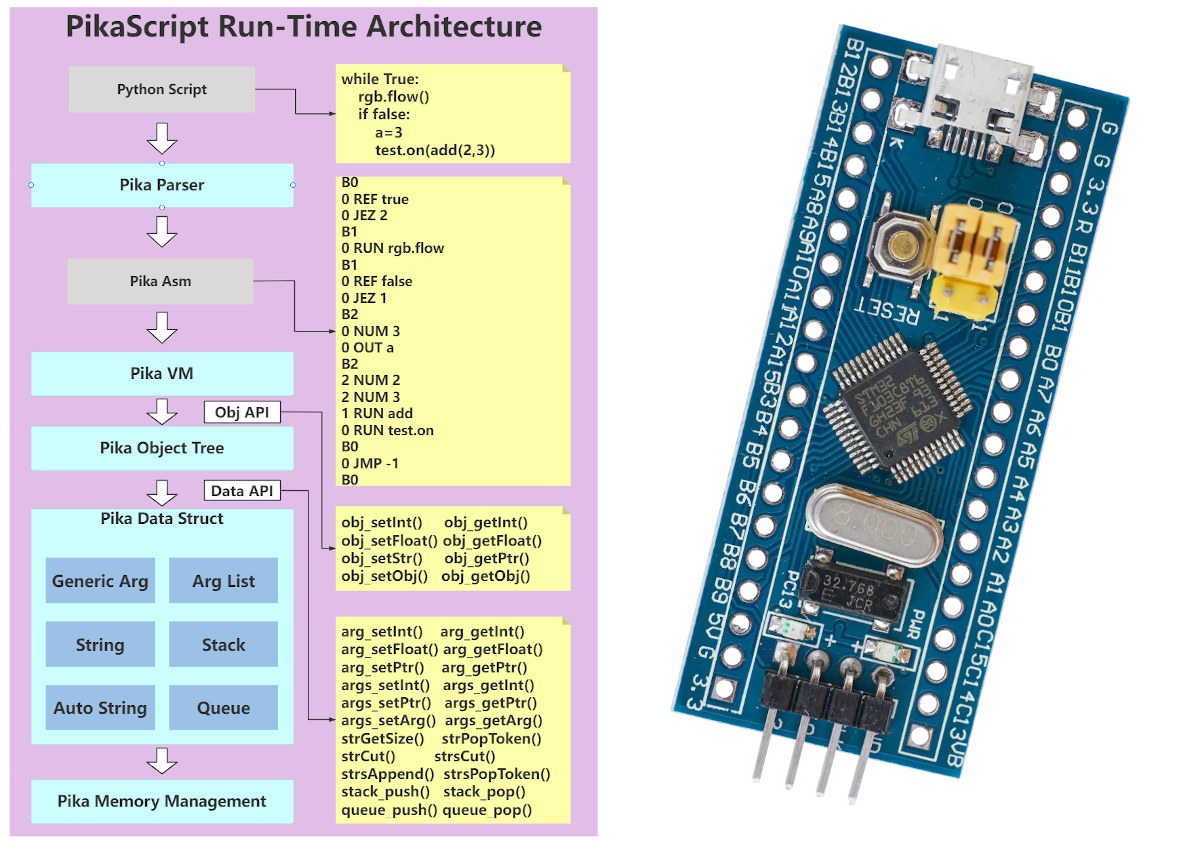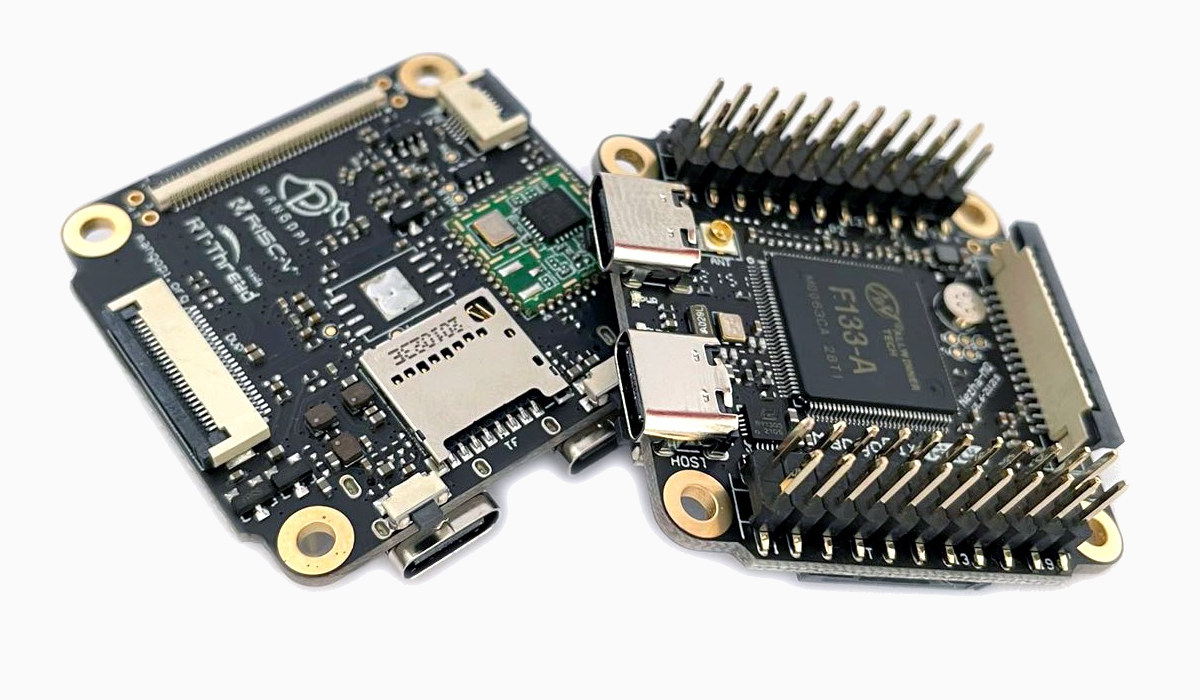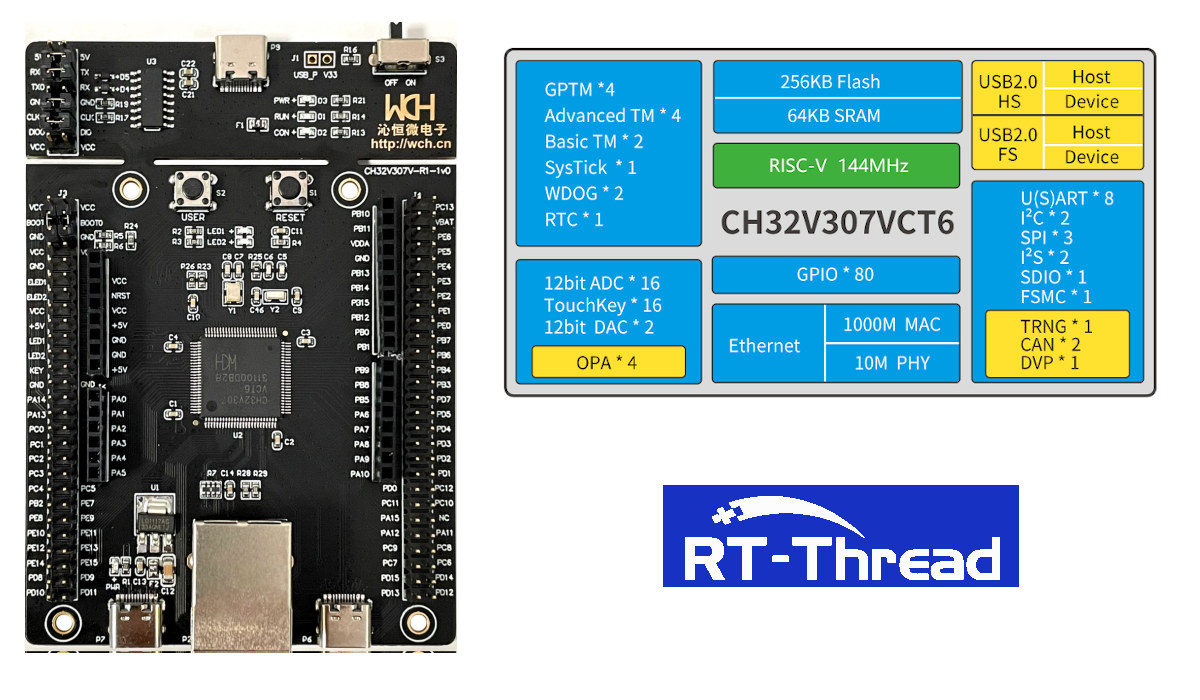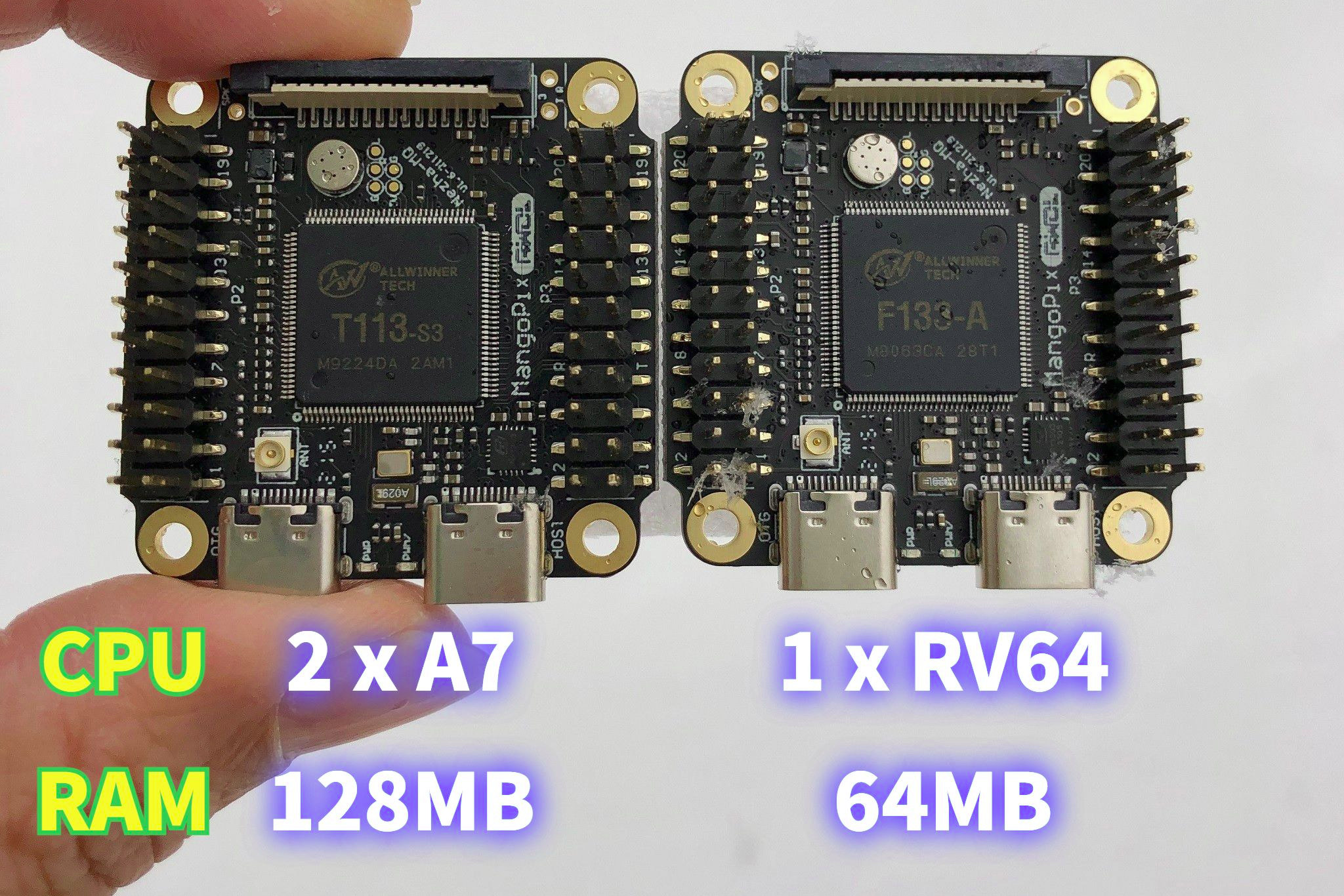Until now, I had only heard about Beken Bluetooth audio chips, but I’ve just been informed the company is also making WiFi chips such as the BK7256 that are notably found in some Tuya Smart Home modules. Beken offers both RISC-V and Arm WiFi and Bluetooth chips with features summarized as follows: BK7235 single-core RISC-V MCU up to 320 MHz with 2.4 GHz WiFi 6 802.11ax and Bluetooth 5.2 LE, 4MB flash, 512KB SRAM, optional 4MB PSRAM BK7236 dual-core Arm MCU up to 120 to 240 MHh with 2.4 GHz WiFi 6 802.11ax and Bluetooth 5.3 dual mode, 4MB flash, 512KB SRAM, optional 4MB PSRAM BK7237 dual-core RISC-V MCU up to 320 MHz with 2.4 GHz WiFi 6 802.11ax and Bluetooth 5.2 dual mode, 4 or 8MB flash, 512KB SRAM, optional 4MB PSRAM BK7256 dual-core RISC-V MCU up to 320 MHz with 2.4 GHz WiFi 6 802.11ax and Bluetooth 5.2 […]
HPMicro HPM64G0 – A 1 GHz RISC-V microcontroller
Yesterday, I ended up on the HPMicro website showing the illustration above about a 1 GHz MCU called HPM64G0. It looked interesting enough so I clicked on the link to a page with some documentation for the company’s HPM6700/6400 microcontrollers. But in typical Chinese fashion, I was asked for a mobile phone number to download the documents. No luck this time since a Chinese mobile phone number is required. If anybody can set up a mirror on Mega or other websites easily accessible outside of China that would be appreciated. But eventually, I found an article in Chinese on EETrend where we can learn more about the HPM64G0 which happens to be a 1GHz microcontroller based on the RISC-V architecture. We already had one of those for Arm with the NXP i.MX RT1170, but I had yet to see any RISC-V microcontrollers clocked at such a high frequency. HPMicro HPM64G0 […]
$4 DshanMCU Pitaya Lite board comes with MM32 Arm Cortex-M3 microcontroller
DshanMCU Pitaya Lite is an MCU development board based on yet another STM32 alternative: MindMotion MM32 Arm Cortex-M3 microcontroller that is said to be compatible with STM32. The MCU can be clocked at up to 120 MHz, embeds 128KB SRAM, 512KB flash, and the board offers two USB Type-C ports for USB and DAP debugging, a MicroSD card slot, a few buttons, I/Os are routed via through holes as well as a mini PCIe connector that can be used to connect a display. Pitaya Lite specifications: MCU – MindMotion Microelectronics MM32F3273G8P Arm Cortex-M3 microcontroller @ 96MHz (standard) to 120MHz (max) with 128KB SRAM, 512kB Flash; LQFP100 package Storage – MicroSD card Display – Via mini PCIe port with FSMC (Flexible Static Memory Controller), supports Intel 8080 LCDs USB – 2x USB Type-C ports, including one for DAPLink and serial access Expansion – 2x 25-pin GPIO headers and Mini PCIe connector […]
DongshanPI-D1s – An Allwinner D1s RISC-V development board designed to teach programming
The DongshanPI-D1s development board is comprised of a soldered-on Allwinner D1s RISC-V system-on-module board (SoM) and a carrier board with two 40-pin headers and a 2.0mm dedicated header. This development board is specifically designed to teach programming with a focus on the RISC-V architecture. The development board was designed by 100ask. They previously designed the Dongshan NeZha STU a development board based on the Allwinner D1. The main difference between the two is that 100ask did not include the Ethernet and HDMI interfaces on the DongshanPI-D1s board. The pinout of the headers is also slightly different because they opted to make the headers compatible with the widely used 40-pin GPIO from Raspberry Pi single board computers. DongshanPI-D1s preliminary specifications: D1s Core Lite SoC – Allwinner D1s single-core XuanTie C906 64-bit RISC-V processor @ 1.0 GHz with with 32 KB I-cache + 32 KB D-cache Memory – 64 MB DDR2 (SIP) […]
PikaScript – A lightweight Python implementation that runs on STM32 and other low-end MCUs
PikaScript is an ultra-lightweight Python engine that can run on microcontrollers with as little as 4KB of RAM and 32KB of Flash, while the more popular MicroPython requires at least 256kB of code space and 16kB of RAM. PikaScript was initially developed to run on STM32G030C8 and STM32F103C8 MCUs, meaning, for example, it works on the BluePill board, but it has also been ported to other platforms like WCH CH582 RISC-V MCU, WinnerMicro W806 C-Sky microcontroller, as well as other like Raspberry Pi RP2040, ESP32-C3, etc… but those are not quite as well supported with some features missing. PikaScript also permits the binding C function to a Python module through Pika Pre-compiler. PikaScript can run bare metal on the microcontroller, but also supports real-time operating systems such as RT-Thread and VSF (Versaloon Software Framework), as well as Linux. Just like MicroPython, it’s using a subset of Python 3, but I’d […]
$39 MangoPi-Nezha MQ RISC-V developer board runs OpenWrt, Debian, or RT-Smart RTOS (Crowdfunding)
MangoPi-Nezha MQ tiny developer board with Allwinner F133-A (aka Allwinner D1s) RISC-V processor with 64MB on-chip RAM has just launched on Crowd Supply for $39, and delivery is expected in July 2022. The 4x4cm development board comes with a MicroSD card slot, display and camera interfaces, an on-board microphone, as well as WiFi connectivity, two USB Type-C ports, and two 22-pin headers for expansion. MangoPi-Nezha MQ specifications: SoC – Allwinner F133-A 64-bit RISC-V processor @ 1 GHz with 64 MB DDR2 Storage MicroSD card slot Footprint for SPI NAND/NOR flash Display I/F 15-pin FPC connector Raspberry Pi DSI display 40-pin FPC connector for RGB display with 4-wire resistive-touch interface 6-pin FPC connector for capacitive touch Camera I/F – 24-pin DVP interface (usable as RMII) Audio – On-board microphone, audio output via 2-pin header (unpopulated) Connectivity 2.4 GHz WiFi 4 via Realtek RTL8189 module plus u.FL antenna connector 10/100Mbps Ethernet (RMII) […]
RISC-V design challenge – Get a free board, RISC-V chips, and cash prizes
A little while ago, I wrote about WCH CH32V307 32-bit RISC-V MCU that was found in a board with eight UART ports that could be controlled over Ethernet or USB, and the company has released some source code to use the board while inviting the community to submit pull requests to the project. But now WCH, RT-Thread, LCSC, and EasyEDA have joined hands to launch the RISC-V design challenge where the companies will provide a free board or two RISC-V chips to selected participants, as well as cash prizes with up to $1000 offered to the best projects. The companies have prepared 300 boards and 200 chips for this contest. All you need to do to get a chance to get either one CH32V307V-EVT-R1 development board or two CH32V307 RISC-V microcontrollers is to enter your contact and project details in this Google form by April 30, 2022. The conditions are […]
RISC-V or Arm? This tiny 4x4cm Linux board with WiFi offers both options
Last fall, we wrote about Allwinner D1s/F133-A RISC-V processor and the upcoming MangoPi MQ1, a tiny 4x4cm board based on the processor. The board is not for sale, but we have more details, and the company is also working on an Arm version equipped with Allwinner T113-S3 dual-core Cortex-A7 processor that is pin-to-pin compatible with F133-A SoC. The Allwinner F133-A board will finally be called MangoPi Nezha-MQ, or MangoPi MQ for shorts, and come with 64MB on-chip RAM while the Allwinner T113-S3 board, with 128MB on-chip RAM, will be named MangoPi MQ-Dual. Both are fitted with a Realtek RTL8189-based Wi-Fi module, offer display and camera interfaces, two USB-C interfaces, and headers for GPIOs. MangoPi MQ RISC-V or Arm Linux board MangoPi MQ/MQ-Dual specifications: SoC (one or the other) MangoPi MQ – Allwinner D1s/F133-A 64-bit RISC-V processor @ 1 GHz with 64 MB DDR2 MangoPi MQ-Dual – Allwinner T113-S3 32-bit dual-core […]


